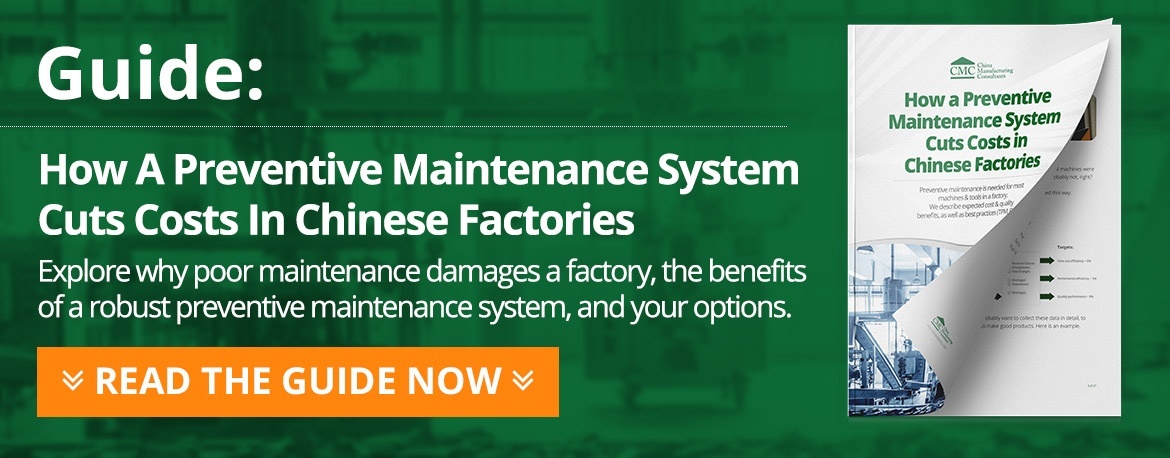Running a 5S program on the shop floor, and then re-running it at a regular interval, is one of the basic initiatives any factory can tackle in order to improve its performance. It is also one of the bases of good preventive maintenance. Let's explore why a 5S program can produce great results in Chinese factories here...
What constitutes a program in a manufacturing operation that has never done any 5S?
It starts with a few cycles of the first 2 S’s, a progressive implementation of the third S, and finally making it an integral part of the management system (the last 3 S’s).
Most 5S's fail because they never get off the ground! So here we’ll focus on the preparation and training, and on the first two S’s.
(Once this is a success, 90% of the hard work has been done.)
What are the first 5 steps in a 5s program?

A. Training
The people who will need to work on 5S and who will need to maintain it need to understand certain basic concepts. They also need to grasp the gap between their current situation and best-class factories.
We typically do 2 rounds of training: one for managers and supervisors, and one for operators.
Showing them photos of their operations, especially the messiest parts we found, is usually eye-opening!
B. Preparation
To reduce resistance from elements inside the organization, we typically prepare a procedure and a checklist (to be used in internal audits) that makes sense for their operations and we have management and the production supervisors approve it.
In some factories it also makes sense to set up a 5S committee – it is a “nice to have” but not a must.
There are usually discussions with the workshop management staff. That’s a good thing, as it results in a better alignment and a readiness to implement the changes.
C. Implementation of 1S (seiri)
We start by setting a clear definition of "necessary" vs. "unnecessary" and applying it to the tools, work-in-process inventory, and anything else that we see in the work space. This discussion results in not only in a standard, but also in tagging a lot of ‘stuff’ as unnecessary.
Once that ‘stuff’ is out of the way, the change is very visible, as a lot of space has been released in the workshops.
This first “S” is often a test for top management – in particular, are local leaders and employees cooperating?
D. Implementation of 2S (seiton)
We work with the operators and their managers on re-designing the layout of the workshop. It typically results in separated areas (with visual indicators such as lines on floor, in new rules (fixed positions, fixed containers, and fixed quantity, in order to make it easier to find materials, tool, and products).
Once a first round of 2S is completed, works find it easier to find and to access products, materials, and tools, and the workshops look much more organized.
E. Implementation of 3S (seiso)
Some equipment and some areas in the shops might not have been cleaned thoroughly in years. Operators and local leaders, together with the maintenance staff if needed (mainly for safety reasons), do deep cleaning work. That’s a must in the first round in 5S.
After that, they need to take the habit of cleaning their work space regularly and, at the same time, looking for abnormalities. A classic example is an oil leak that might not be noticed under a layer of dust but that becomes quite visible when the hose is clean.
Once operators are trained, all they need to devote to this activity is usually 5 minutes at the start of their shift.
Note: when the 3rd S of 5S is done very well, it covers the “autonomous maintenance” section of Total Productive Maintenance. If your operations make use of expensive equipment, or when poorly maintained machines might create severe quality issues, doing a great work at 5S saves tremendous money.
The last 2 S’s are often a struggle at another level in most Chinese factories, for the simple reason that they have no management system. Someone needs to spend the energy to launch a new 1-2-3S round every few months. That’s another topic…
What are the main benefits of a 5S program?

Here is what we have observed:
- A lot of space is freed up, which then can be used to grow the activity or to set up point-of-use inventory (which in turn avoids much transportation and double-handling waste).
- Better storage or materials, including segregation of non-conforming parts, which reduces quality issues.
- Regularly cleaned and inspected equipment is less likely to break down unexpectedly, especially if 5S efforts are accompanied by preventive maintenance.
- Much better personal safety, since gangways are clear of cables, welding tips not laying on a wet floor, wood-cutting waste not accumulating in corners, and so on.
- Well-presented tools reduce the time to look around and to fetch these tools.
What is 5S often mistaken for?
Many people present 5S as “good housekeeping”. But they miss an important point: the purpose of 5S is NOT to have a clean and well-organized workplace, or to impress visitors. We have seen some Chinese factories approach 5S as a way to gain a marketing advantage, and I am not sure it should be called “5S”.
We wrote about this before in Doing A 5S Program In A Chinese Factory: Cleanliness And Much More.
Should it be a program, or part of the system?
Sustaining 5S efforts and transitioning from a “program” to “the way things are done here” is another topic. It has everything to do with the company’s management system (and how much grip that system has over the local leaders and the operators). That’s a different recipe…
If your quality management system is really effective, make 5S a part of it. if you have a good asset management (i.e. maintenance) system, same thing.
Otherwise, the organization might struggle, unless a high-level manager keeps pushing for new rounds of 5S.
Your say...
Are you using 5s in your, or your supplier's, Chinese factory? How is that going? If you have sticking points, what are they?
Please share your experiences, and any questions you may have, by leaving a comment below this blog post. I'll be pleased to respond and help you.




